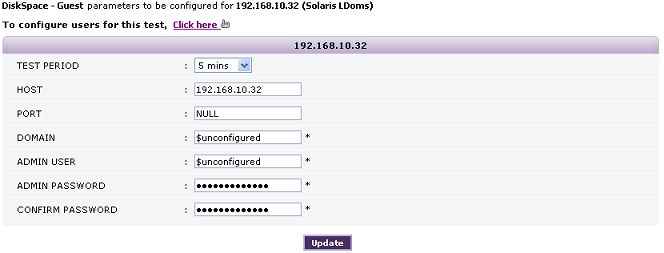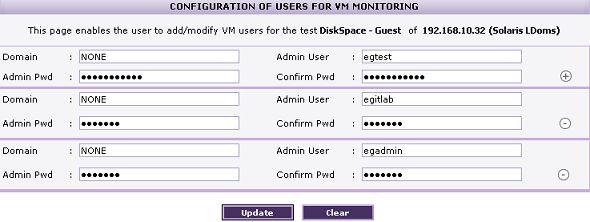Disk Space - OS Test
This test reports statistics pertaining to the space usage of each physical disk on a guest, and across all disk partitions on a guest.
Target of the test : A Oracle LDoms server
Agent deploying the test : An internal agent
Outputs of the test : One set of results for every combination of virtual_guest:disk_partition; for every guest, a set of measures will be reported for the virtual_guest:Total descriptor as well – these measures will indicate the total disk space usage across all disk partitions on that guest.
| Parameter | Description |
|---|---|
|
Test period |
How often should the test be executed |
|
Host |
The host for which the test is to be configured. |
|
Port |
The port number at which the specified host listens. By default, the port is NULL. |
|
Domain |
Specify the domain within which the virtual guests reside. Since the Oracle LDoms server supports only Oracle and Linux guests, this parameter should always be set to none. |
|
Admin User |
This test connects to each virtual guest and collects status and resource usage statistics from the guest. In order to do so, the test must be configured with user privileges that allow a remote connection to the virtual guest from the Oracle host. If a single user has access to all the guest domains on the Oracle server, specify the name of that user against Admin User, and specify his password against Admin Password. On the other hand, if the user credentials vary from one guest to another, then multiple Admin Users and Admin Passwords might have to be specified for every Oracle LDoms server being monitored. To help administrators provide these user details quickly and easily, the eG administrative interface embeds a special configuration page. To access this page, simply click on the Click here hyperlink that appears just above the parameters of this test in the test configuration page. To know how to use the special page, refer to Configuring Users for VM Monitoring. |
|
Admin Password |
The password of the Admin User needs to be provided here. Here again, if multiple passwords need to be specified, then follow the procedure detailed in Configuring Users for VM Monitoring. |
|
Confirm Password |
Confirm the password by retyping it here. Here again, if multiple passwords need to be confirmed, then follow the procedure detailed in Configuring Users for VM Monitoring. |
| Measurement | Description | Measurement Unit | Interpretation |
|---|---|---|---|
|
Total capacity |
Indicates the total capacity of a disk partition. |
MB |
|
|
Used space |
Indicates the amount of space used in a disk partition. |
MB |
|
|
Free space |
Indicates the current free space available for each disk partition of a system. |
MB |
|
|
Percent usage |
Indicates the percentage of space usage on each disk partition of a system. |
Percent |
A value close to 100% can indicate a potential problem situation where applications executing on the guest may not be able to write data to the disk partition(s) with very high usage. |
Configuring Users for VM Monitoring
In order to enable the eG agent to connect to VMs and pull out metrics from them, the eG administrative interface provides a special page using which the different Admin User names and Admin Passwords can be specified. To access this page, just click on the Click here hyperlink in any of the VM test configuration pages.

Figure 1 : Configuring a VM test
Upon clicking, Figure 2 will appear, using which the VM user details can be configured.

Figure 2 : The VM user configuration page
To add a user specification, do the following:
-
By default, NONE will be displayed against Domain.
-
The eG agent must be configured with user privileges that will allow the agent to communicate with the VMs on a Oracle server and extract statistics. Specify of the name of such a user the Admin User text box.
-
The password of the specified Admin User should be mentioned in the Admin Pwd text box.
-
Confirm the password by retyping it in the Confirm Pwd text box.
-
To add more users, click on the
 button in Figure 2. This will allow you to add one more user specification as depicted by Figure 3.
button in Figure 2. This will allow you to add one more user specification as depicted by Figure 3. 
-
Similarly, multiple user specifications can be provided.

-
To clear all the user specifications, simply click the Clear button in Figure 4.
-
To remove the details of a particular user alone, just click the
 button in Figure 4.
button in Figure 4. -
To save the specification, just click on the Update button in Figure 4. This will lead you back to the test configuration page, where you will find the multiple domain names, user names, and passwords listed against the respective fields.



